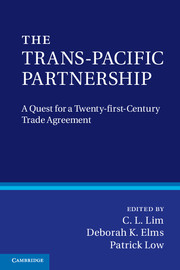Book contents
- Frontmatter
- Contents
- List of Figures and Tables
- Contributors
- Preface
- Acknowledgements
- Disclaimer
- Glossary
- Part I Introduction
- Part II The past: origins of the TPP Agreement
- Part III The present: twenty-first century elements and obstacles
- Part IV The future: high-quality meets regional and global realities
- 15 Achieving a Free Trade Area of the Asia-Pacific
- 16 APEC and the TPP
- 17 Coping with multiple uncertainties
- 18 The TPP
- 19 The TPP in a multilateral world
- Part V The TPP negotiations: the quest for quality
- Index
- References
18 - The TPP
multilateralizing regionalism or the securitization of trade policy?
Published online by Cambridge University Press: 05 November 2012
- Frontmatter
- Contents
- List of Figures and Tables
- Contributors
- Preface
- Acknowledgements
- Disclaimer
- Glossary
- Part I Introduction
- Part II The past: origins of the TPP Agreement
- Part III The present: twenty-first century elements and obstacles
- Part IV The future: high-quality meets regional and global realities
- 15 Achieving a Free Trade Area of the Asia-Pacific
- 16 APEC and the TPP
- 17 Coping with multiple uncertainties
- 18 The TPP
- 19 The TPP in a multilateral world
- Part V The TPP negotiations: the quest for quality
- Index
- References
Summary
A proliferation of preferential trade agreements (PTAs) has been the dominant trend in international trade arrangements since the conclusion of the Uruguay Round (World Trade Organization, 2011a). The expansion in the number of PTAs and the growing share of global trade they cover has caused increasing disquiet among many trade policy officials and academics. The principal anxieties are summarized succinctly in the words of Pascal Lamy, Director-General of the World Trade Organization (WTO): “Proliferation is breeding concern – concern about incoherence, confusion, unnecessary business costs, instability, and unpredictability in trade relations” (Lamy, 2009).
Although the WTO itself notes that the evidence of the effects of PTAs on the global trading system are far from being unambiguously negative (World Trade Organization, 2011c), the explosion of preferential agreements raises two principal sets of issues. The first is that PTAs at best distract from liberalization at the global level; at worst, the existence of preferences may hinder or complicate moves towards multilateral liberalization. Second, multiple preferential agreements, with their associated rules of origin, complicate the task of managing global supply chains and have the potential to generate economic inefficiencies; for further discussion see Baldwin (2009).
- Type
- Chapter
- Information
- The Trans-Pacific PartnershipA Quest for a Twenty-first Century Trade Agreement, pp. 279 - 298Publisher: Cambridge University PressPrint publication year: 2012
References
- 7
- Cited by

